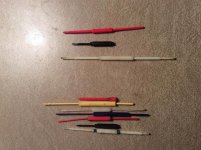tempest
Veteran Member
I just got a non-gate array 4P and it appears to be working just fine in Model III mode and 40 column Model 4 mode. But when I try to load a DOS that uses the 80 column mode (LDOS 6.3.1. MULTIDOS 2.1, TRSDOS 6.2.1) the screen is scrambled. The seller told me that I might need to adjust the video display. I found something about adjusting a capacitor on the board on Ira's site:
Has anyone done this before? If so are there any tips you can share? Is there a video or picture showing where this capacitor is exactly? I assume I do this with the system off and keep adjusting it until it stops being scrambled.
If you happen to have the non-gate array mother board in your 4/4P and the video screen is “shakey” in the model 4 mode or speed and is NOT while in the model 3 mode, the video VCO (voltage controlled oscillator) which generates the 80 character by 26 line signal is probably on the edge of stability. This sometimes shows up more as the ‘puter warms up.
On the 4P: in the front of the board, between U148 and U149 there is a variable capacitor (usually orange in color) designated C231, but you probably can’t read the designation. It is about 3/8 inch in diameter, and has a whole in the top with what looks like a screw slot in the hole, you are looking at what is probably the culprit!! Using an insulated shaft TUNING tool that will fit into the hole, with the ‘puter in the model 4 and the ‘puter warmed up so the symptoms appear, adjust (just a WEE TAD) so the video is again stable. Do this gently or you’ll hate me!
Has anyone done this before? If so are there any tips you can share? Is there a video or picture showing where this capacitor is exactly? I assume I do this with the system off and keep adjusting it until it stops being scrambled.

